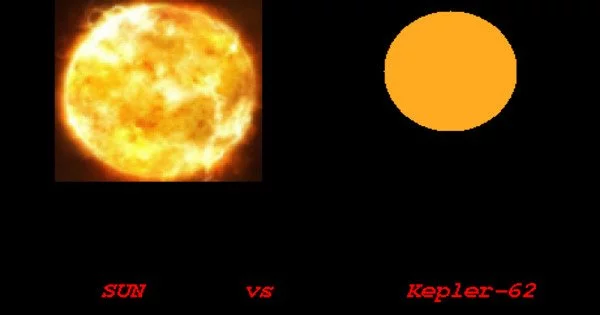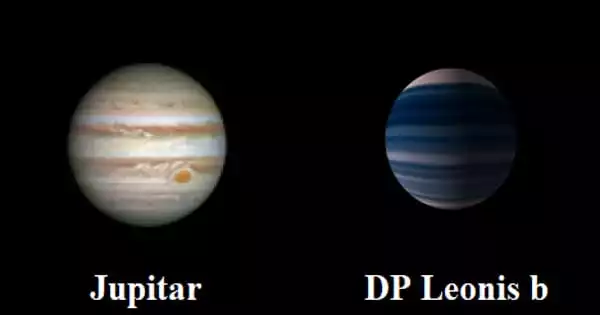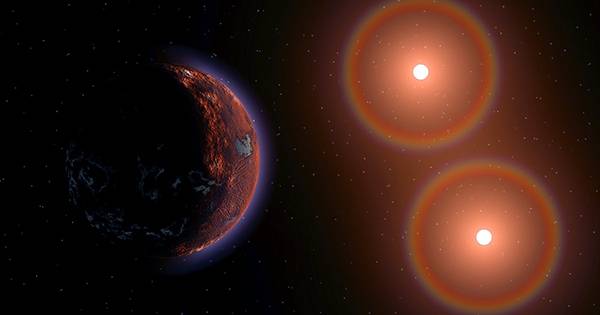Kepler-62 is a K-type main sequence star located approximately 990 light years from Earth in the constellation Lyra. It is in the field of view of the Kepler spacecraft, which was used by NASA’s Kepler Mission to detect planets that may be transiting their stars. It was announced on April 18, 2013, that the star has five planets, two of which, Kepler-62e and Kepler-62f, are within the star’s habitable zone. Kepler-62f, the most distant, is most likely a rocky planet.
Nomenclature and history
Kepler-62 was assigned the 2MASS catalogue number 2MASS J18525105+4520595 prior to Kepler observation. It is designated as KIC 9002278 in the Kepler Input Catalog, and when transiting planet candidates were discovered, it was given the Kepler object of interest number of KOI-701.
NASA’s Kepler Mission, which is tasked with discovering planets in transit around their stars, detected planetary candidates in the vicinity of the star. Kepler’s transit method involves detecting brightening dips in stars. These brightness dips can be attributed to planets whose orbits pass in front of their stars from Earth’s perspective, though other phenomena may also be to blame, which is why the term planetary candidate is used.

Following the publication of the discovery paper, the Kepler team named the system “Kepler-62.” The star was named Kepler-62 by the discoverers, as is the standard procedure for naming the exoplanets discovered by the spacecraft. As a result, this is the name given to the star and its planets by the general public.
Candidate planets that are associated with stars studied by the Kepler Mission are assigned the designations “.01”, “.02”, “.03”, “.04”, “.05” etc. after the star’s name, in the order of discovery. If planet candidates are detected simultaneously, then the ordering follows the order of orbital periods from shortest to longest. Following these rules, the first three candidate planets were detected simultaneously, with orbital periods of 18.16406, 5.714932, and 122.3874 days, respectively, in the 2011 data release, with another two candidate planets, with orbital periods of 267.29 and 12.4417 days, respectively, being detected in a 2012 data release by the Kepler spacecraft.
The letters b, c, d, e, and f refer to the order of discovery. The letter b is assigned to the first planet orbiting a given star, followed by the remaining lowercase letters of the alphabet. Because all of the known planets in the Kepler-62 system were announced at the same time, b is assigned to the closest planet to the star and f to the farthest. The star’s name, Kepler-62, is derived directly from the fact that it is the 62nd star discovered by Kepler to have confirmed planets.
Stellar characteristics
Kepler-62 is a K-type main sequence star with 69% the mass and 64% the radius of the Sun. It is 7 billion years old and has a temperature of 4925 K. The Sun, on the other hand, is approximately 4.6 billion years old and has a temperature of 5778 K.
The star has a metallicity ([Fe/H]) of about -0.37, or about 42% of the amount of iron and other heavier metals found in the Sun, which is comparable to Kepler-442. The star’s luminosity is typical for a star like Kepler-62, with a luminosity that is approximately 21% of that of the sun.
The apparent magnitude of the star, or how bright it appears from Earth, is 13.75. Therefore, it is too dim to be seen with the naked eye.
Planatary system
All known planets transit the star, which means that their orbits appear to cross in front of their star from Earth’s perspective. Their inclinations to the Earth’s line of sight, or how far above or below the plane of sight they are, differ by less than one degree. By monitoring each planet’s transit of the star, direct measurements of the planets’ periods and relative diameters (in comparison to the host star) are possible. The exact eccentricity of the planets is unknown, but estimates place it very close to zero, resulting in a mostly circular orbit for the planets.
















